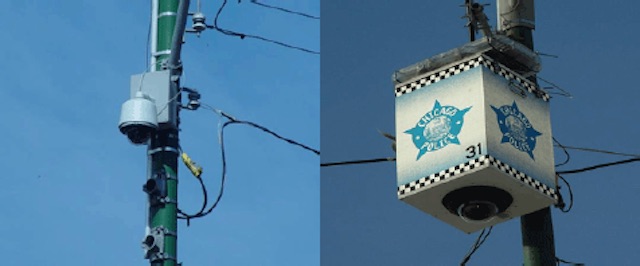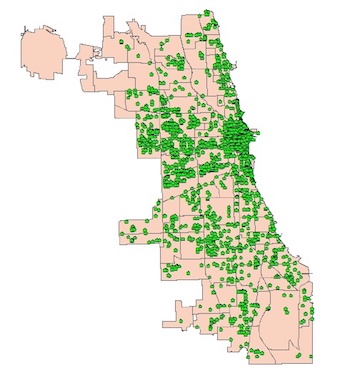Chicago Has 2.7K Surveillance Cameras, & No One Entirely Knows Who's Watching (Or Isn't)
By Emma G. Gallegos in News on Dec 13, 2016 9:08PM

Newer cameras from Office of Emergency Management and Communications are more discreet, the older cameras installed by the Chicago Police Department are more visible and intended as a deterrent (Office of Inspector General)

A map of the city's cameras (Office of Inspector General)
The city's watchdog conducted a deep dive into the management of the city's vast network of over 2,700 surveillance cameras. One of the most troubling findings from the report is that, more than a decade after the first cameras were installed, there still isn't a good way to figure out who has access to those cameras, particularly among police. This has privacy advocates and critics of police transparency worried.
The city's first cameras were rolled out by the Chicago Police Department in 2003. Later the Office of Emergency Management and Communications (OEMC) installed cameras, and the two were eventually combined into one network. They are supposed to deter crime as well as help city, state and federal agencies with investigations into crime, terrorism and even traffic crashes. So far $140 million in taxpayer funds have been used.
A report that came out Tuesday from Office of Inspector General Joe Ferguson says that his office found that there is poor management of who has access to city's cameras. He writes, "We found that OEMC did not comply with, and did not require other departments to comply with, citywide policies regulating access to information systems."
There is very little regulation over access, which privacy advocates find troubling. There is no database that shows who does and who doesn't have access to the city's network of cameras. To access the network, many officials would use a group login rather than an individual one. Passwords wouldn't be changed with any regularity. There wasn't any regular audit of who did or didn't need access—such as when employees moved departments, stopped working or hadn't used the network over a long period. In his report, Ferguson recommends all of this be changed. Each individual should have their own login with a regularly changed password and their need for access should be regularly reviewed.
The good news is that OEMC has already implemented some of these changes in their office. The bad news is that the one department that you'd hope would have the strictest regulation—the Chicago Police Department—is the least regulated. To this day, each police station has their own group logon, so it's never clear who is access cameras.
Ferguson notes in his report that this created a big problem when his office tried to investigate an allegation that an officer at a station working remotely manually turned a camera away from the scene of an arrest that allegedly involved police misconduct. Attorney Torri Hamilton sued and won $7,500 for the wrongful arrest of Isaac Gibson in 2009, but she believes the award could have been higher if they could have proved who had access to the cameras. WBEZ reported in 2011 what happened during Gibson's arrest:
Police officers can control the cameras from desktop computers at the stations. It's clear this camera is taken over manually—it's no longer circling every minute. The recording shows that the officer controlling this camera briefly scanned the vacant lot where the party was and then zoomed down the sidewalk.And that, strangely, is where it stays.
Everything is pixilated and out of focus. It's tough to figure out what the camera operator was trying to see, which is why Hamilton thinks it was deliberately diverted away from the action on the street.
Six years ago, the American Civil Liberties Union demanded that the city update its privacy principles for its surveillance network—to little effect. ACLU spokesmen Ed Yohnka says that Pittsburgh and Washington D.C. both have "publicly-adopted privacy standards" that are audited every single year, and they should serve as a model for Chicago.
"This shouldn’t have had to wait this many years for an audit to come out. The city should have been reporting on this. Not in some vague way, but in a specific way,” Yohnka told the Chicago Sun-Times.
He told the Tribune that Ferguson's report was "disturbing but not surprising" given its previous demands.
"Today's report shows that OEMC cannot even guarantee that only those who have authorization used and manipulated surveillance cameras," Yohnka said in a prepared statement. "In short, we do not know if individuals within OEMC or CPD have used the cameras to invade individuals' privacy or hide police misconduct."
If you want to read the report for yourself, here is the 30-page audit from the Office of Inspector General (via the Sun-Times):
Audit of OEMC Public Safety Cameras by Steve Warmbir on Scribd